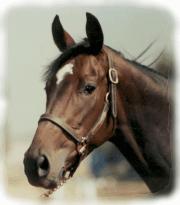A Horse, of Course with Don Blazer |
If you enjoy learning about horses, then you'll love our online courses. Each month you'll find a new column on our web site. We hope you'll enjoy it, and maybe e-mail us with questions or suggestions for other columns. A Horse, Of Course is a monthly column syndicated by Success Is Easy. If you like the column, call your local newspaper, or local horse publication and ask them to subscribe by contacting Success Is Easy. |
Change Your Horse Show Routine Don Blazer copyright©2012 |

If you’re an amateur rider
who thinks it’s your fault your horse doesn’t perform in the show ring the same
way for you that it does for your trainer, erase that thought. It’s
very likely not your fault! It may be true the horse doesn’t perform at the same level for you as he does for the trainer, but the reason may lie in “Stimulus Control” and not a lack of ability on your part. Stimulus Control is a signal that indicates to the horse the specific type of behavior expected. When you approach your horse with a bucket of grain or flakes of hay, Stimulus Control tells the horse he’s going to eat. When you approach with a halter, the horse has a pretty good idea you are going for a ride, or if you have been “doctoring” the horse for the last two weeks, the horse thinks, “here it comes again.” Stallions that are both breeding and performing know the difference between a breeding halter and a working halter. And your horse knows the difference between you and your trainer. When you get to a show, it is common for the trainer to “school” your horse for you. You are most likely standing around waiting for the trainer to “get the horse ready.” The horse knows what is going on! The trainer is working to get the horse collected, nose in, head down, slowing gaits, stopping square, turning on the hindquarters, side passing, working trail obstacles or taking warm-up jumps. You think because you’ve hired the trainer, it’s part of the trainer’s job to get the horse ready…at least that’s the common way of doing things. Once the trainer has the horse working, you are ready to get on. The mounting block comes out, or you mount and someone helps pull your chaps down around your boots. Stimulus Control goes into effect because the “routine“ is right on schedule…and your horse knows what is going on; it’s time to relax a little. You walk the horse around and around until you enter the show pen and the horse does his job, but not at the same level as he was working for the trainer….Stimulus Control signals the horse that it is perfectly okay to ease through the class since you never “demand” a higher level of performance. To make matters worse, often you come out of the class and the trainer jumps on the horse again and goes back to “schooling.” Stimulus Control is reinforced. It’s simple to “reprogram” the stimulus control and change your show pen performances. When you go to a show, never have the trainer ride your horse! You ride your horse, and if he needs schooling, you do it while your trainer gives you assistance from the ground. After a few shows, your horse will know that you are doing the schooling and you are signaling the kind of behavior you expect in the show pen. If the trainer has done his or her job during the week, then “training” at the show isn’t necessary. Preparing to perform (a warm up and light testing to see that all parts are responding to cues) is all that is needed. Stimulus Control will then be working to your advantage. |